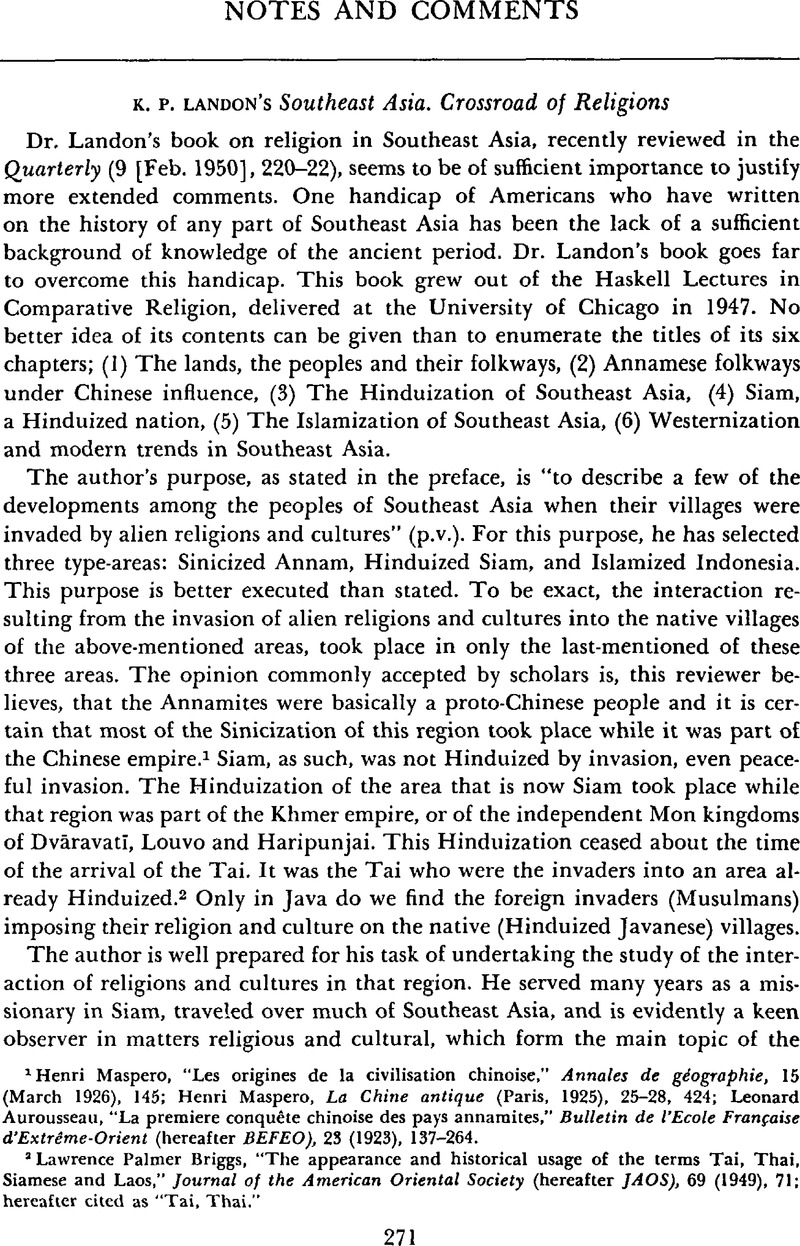Article contents
K. P. Landon's Southeast Asia. Crossroad of Religions
Published online by Cambridge University Press: 23 March 2011
Abstract

- Type
- Notes and Comments
- Information
- Copyright
- Copyright © Association for Asian Studies, Inc. 1951
References
1 Maspero, Henri, “Les origines de la civilisation chinoise,” Annales de géographic, 15 (March 1926), 145Google Scholar; Maspero, Henri, La Chine antique (Paris, 1925), 25–28, 424Google Scholar; Aurousseau, Leonard, “La premiere conquête chinoise des pays annamites,” Bulletin de l'Ecole Française d'Extrême-Orient (hereafter BEFEO), 23 (1923), 137–264.CrossRefGoogle Scholar
2 Briggs, Lawrence Palmer, “The appearance and historical usage of the terms Tai, Thai, Siamese and Laos,” Journal of the American Oriental Society (hereafter JAOS), 69 (1949), 71; hereafter cited as “Tai, Thai.”CrossRefGoogle Scholar
3 Coedès, George, Les états hindouisés d'Indochine et d'Indonesie (Paris, 1948), 289.Google Scholar
4 Boulanger, Paul Le, Histoire du Laos française (Paris, 1930) 35–41; Briggs, “Tai, Thai,” 65, 70.Google Scholar
5 Briggs, “Dvāravatī, the most ancient kingdom of Siam,” JAOS, 65 (1945), 104.Google Scholar
6 The term Menam, which has a long-established usage by the best writers on the subject, is here used to designate the whole river system, except its northwest affluent—the upper Meping—which was the seat of the independent Mon kingdom of Haripunjai.
7 Briggs, “Tai, Thai,” 71; Coedès, , “L'année du lièvre, 1219 A.D.,” India antiqua (1947), 82–88.Google Scholar
8 Briggs, “Tai, Thai,” 67–68.
9 G. E. Harvey, A history of Burma (London, 1925), 110–11.
10 Coedès, , “Documents sur l'histoire politique et religieuse du Laos occidental,” BEFEO, 25 (1925), 80.CrossRefGoogle Scholar
11 Ibid., 159.
12 Coedès, G. et Pierre Dupont, “L'inscription de Sdok Kak Thorn (hereafter cited as “S.K.T.”), BEFEO, 43 (1943–1946), 72.Google Scholar
13 Coedès, “Documents, etc.,” 159.
14 Coedès, , “Le royaume de Çrlvijaya,” BEFEO, 18, no. 6 (1918), 1–36CrossRefGoogle Scholar; Briggs, , “The origin of the Śailendra dynasty. Present status of the question” (hereafter cited as “Śailendra”), JAOS, 70 (1950), 78.Google Scholar
15 Briggs, , “The Khmer empire and the Malay peninsula,” Far Eastern quarterly, 9 (May 1950), 275–76CrossRefGoogle Scholar, hereafter “Malay peninsula;” Coedès, “Le royaume de Çrīivijaya: 1. Inscription de Vieng Sa (error for Ligor),” 29–31; Vogel, J. Ph., “Het koninkrijk Śrīvijaya,” Bijdragen tot de taal, land-en volkenkunde van Nederlandisch-Indie, 75 (1919), 626–37.CrossRefGoogle Scholar
16 Briggs, “Śailendra,” 80: Śāstrī, Hiranandra, “The Nālandā copperplate of Devapaladeva,” Epigraphie Indica, 17 (1923–1924). 310–27.Google Scholar
17 Coedès, Etats hindouisés, 183–86, 214–20; Briggs “Malay peninsula,” 279.
18 Briggs, “Malay peninsula,” 277; Ferrand, Gabriel, L'empire sumatranais de Çrīvijaya (Paris, 1922), 52–59.Google Scholar
19 Briggs, “Malay peninsula,” 274–80.
20 Ferrand, Çrīvijaya, 61.
21 Finot, Louis, “Notes d'epigraphie: 15. L'inscription de Sdok Kak Thom,” BEFEO, 15 (1915), 87, stanzas 61–64.Google Scholar
22 Finot, “S.K.T.,” 88, st. 12–13.
23 Coedès, “Etudes cambodgienne: 21. Les traditions génealogiques des premiers rois d'Angkor; d'apres les inscriptions de Yaśovannan I et de Rājendravarman II,” BEFEO, 28 (1928), 132.
24 Briggs, , The ancient Khmer empire (Philadelphia: American Philosophical Society, 1951), 82.Google Scholar
25 Finot, “S.K.T.,” 88, St. 69–78.
26 Briggs, , “A sketch of Cambodian history,” FEQ, 6 (Aug. 1947), 350.Google Scholar
27 Coedès, , “Etudes cambodgienne: 87. La cite de Janapada d'après une inscription de Prasat Khna,” BEFEO, 43 (1943–1946), 8–11.Google Scholar
28 Finot, “S.K.T.,” 87–88, st. 61–78; Coedès et Dupont, “L'inscription de Sdok Kak Thom,” BEFEO, 43 (1943–46), 96, st. 27; 106–10, st. 61–77.
29 Finot, “S.K.T.,” 88, st. 69–78; also Coedès et Dupont, “S.K.T.,” 106–10, St. 61–77.
30 Finot, “S.K.T.,” 80, st. 29; Coedès et Dupont, ibid., 96, St. 29.
31 Stern, Philippe, “Le temple montagne-khmer; le culte du linga et le devarāja,” BEFEO, 34 (1934), 614–15.CrossRefGoogle Scholar
32 Briggs, , “The Hinduired states of Southeast Asia: a review,” FEQ, 7 (Aug. 1948), 388–89.Google Scholar
33 Coedès, Etats hindouisés, 68.
34 Briggs, “The Hinduized states,” 386.
35 Coedès, , “La stele de Ta Prohm,” BEFEO, 6 (1906), st. 36.CrossRefGoogle Scholar
36 Coedès, , “Le stele de Prah Khan d'Angkor,” BEFEO, 40 (1940), st. 36.Google Scholar
37 Coedès, , “Nouvelles découvertes à Angkor,” Cahiers de l'EFEO, nos. 20–21 (1939), 18–19.Google Scholar
38 Briggs, , “The syncretization of religions in Southeast Asia, especially in Cambodia,” JAOS, 71 (1951).Google Scholar
39 Barth, Auguste, “Inscriptions Sanscrites du Cambodge: 17. Lovek,” in Académic des Inscriptions et Belles-Lettres: notices et extraits des manuscrits (Paris, 1885), B st. 32.Google Scholar
40 Sir Monier-Williams, Monier, Brahmanism and Hinduism (London, 1891), 74–75Google Scholar; Sir Eliot, Charles, Hinduism and Buddhism (London, 1921), 3: 114.Google Scholar
41 Dowson, John, A classical dictionary of Hindu mythology and religion, geography, history and literature (London, 1878), 177.Google Scholar
42 Foucher, Alfred, “The influences of Indian art in Cambodia and Java,” in Sir Asutoch Mookerjee silver jubilee volumes (Calcutta, 1922), 3:1, 23.Google Scholar
43 Coedès, Pour mieux comprendre Angkor (Paris, 1947), 142–43.Google Scholar
44 Coedès, , “Les bas'Angkor Wat,” Bulletin de la Commission Archéologique de l'Indochine (1911), 203.Google Scholar
45 Briggs, “Tai, Thai,” 62, especially note 19.
46 Quaritch-Wales, H. G., Toward Angkor (London, 1937), 102Google Scholar; Dupont, , “Variétés archéologues: 1. Vishnu mitrés de l'Indochine occidentale,” BEFEO, 42 (1942), 233.Google Scholar
47 Briggs, , “Siamese attacks on Angkor before 1430,” FEQ, 8 (Nov. 1948), 3–33.Google Scholar
- 1
- Cited by




